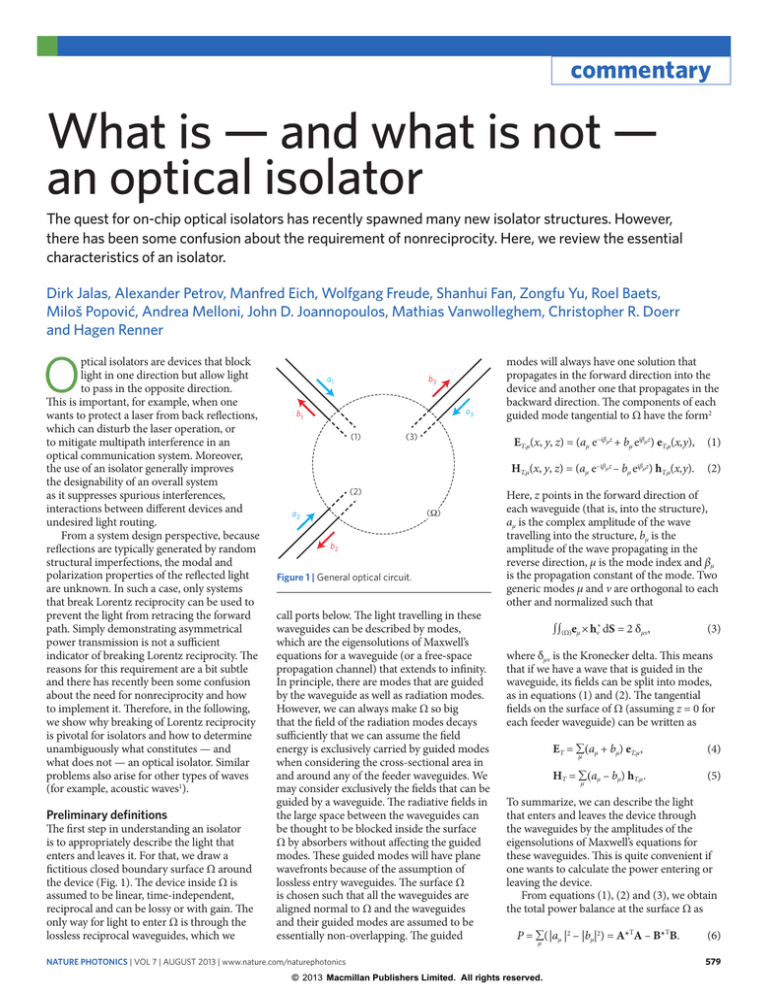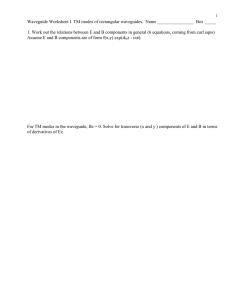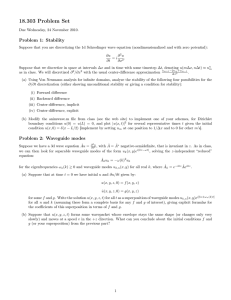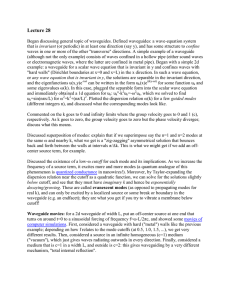What is — and what is not — an optical isolator
advertisement

commentary What is — and what is not — an optical isolator The quest for on-chip optical isolators has recently spawned many new isolator structures. However, there has been some confusion about the requirement of nonreciprocity. Here, we review the essential characteristics of an isolator. Dirk Jalas, Alexander Petrov, Manfred Eich, Wolfgang Freude, Shanhui Fan, Zongfu Yu, Roel Baets, Miloš Popović, Andrea Melloni, John D. Joannopoulos, Mathias Vanwolleghem, Christopher R. Doerr and Hagen Renner O ptical isolators are devices that block light in one direction but allow light to pass in the opposite direction. This is important, for example, when one wants to protect a laser from back reflections, which can disturb the laser operation, or to mitigate multipath interference in an optical communication system. Moreover, the use of an isolator generally improves the designability of an overall system as it suppresses spurious interferences, interactions between different devices and undesired light routing. From a system design perspective, because reflections are typically generated by random structural imperfections, the modal and polarization properties of the reflected light are unknown. In such a case, only systems that break Lorentz reciprocity can be used to prevent the light from retracing the forward path. Simply demonstrating asymmetrical power transmission is not a sufficient indicator of breaking Lorentz reciprocity. The reasons for this requirement are a bit subtle and there has recently been some confusion about the need for nonreciprocity and how to implement it. Therefore, in the following, we show why breaking of Lorentz reciprocity is pivotal for isolators and how to determine unambiguously what constitutes — and what does not — an optical isolator. Similar problems also arise for other types of waves (for example, acoustic waves1). Preliminary definitions The first step in understanding an isolator is to appropriately describe the light that enters and leaves it. For that, we draw a fictitious closed boundary surface Ω around the device (Fig. 1). The device inside Ω is assumed to be linear, time-independent, reciprocal and can be lossy or with gain. The only way for light to enter Ω is through the lossless reciprocal waveguides, which we a1 b3 a3 b1 (1) (3) modes will always have one solution that propagates in the forward direction into the device and another one that propagates in the backward direction. The components of each guided mode tangential to Ω have the form2 ET,μ(x, y, z) = (aμ e−iβμz + bμ eiβμz) eT,μ(x,y),(1) HT,μ(x, y, z) = (aμ e−iβμz – bμ eiβμz) hT,μ(x,y).(2) (2) (Ω) a2 b2 Figure 1 | General optical circuit. call ports below. The light travelling in these waveguides can be described by modes, which are the eigensolutions of Maxwell’s equations for a waveguide (or a free-space propagation channel) that extends to infinity. In principle, there are modes that are guided by the waveguide as well as radiation modes. However, we can always make Ω so big that the field of the radiation modes decays sufficiently that we can assume the field energy is exclusively carried by guided modes when considering the cross-sectional area in and around any of the feeder waveguides. We may consider exclusively the fields that can be guided by a waveguide. The radiative fields in the large space between the waveguides can be thought to be blocked inside the surface Ω by absorbers without affecting the guided modes. These guided modes will have plane wavefronts because of the assumption of lossless entry waveguides. The surface Ω is chosen such that all the waveguides are aligned normal to Ω and the waveguides and their guided modes are assumed to be essentially non-overlapping. The guided Here, z points in the forward direction of each waveguide (that is, into the structure), aμ is the complex amplitude of the wave travelling into the structure, bμ is the amplitude of the wave propagating in the reverse direction, μ is the mode index and βμ is the propagation constant of the mode. Two generic modes μ and ν are orthogonal to each other and normalized such that ∫∫(Ω)eμ × hv* dS = 2 δμv, (3) where δμν is the Kronecker delta. This means that if we have a wave that is guided in the waveguide, its fields can be split into modes, as in equations (1) and (2). The tangential fields on the surface of Ω (assuming z = 0 for each feeder waveguide) can be written as ET = ∑ (aμ + bμ) eT,μ ,(4) μ HT = ∑ (aμ – bμ) hT,μ . μ (5) To summarize, we can describe the light that enters and leaves the device through the waveguides by the amplitudes of the eigensolutions of Maxwell’s equations for these waveguides. This is quite convenient if one wants to calculate the power entering or leaving the device. From equations (1), (2) and (3), we obtain the total power balance at the surface Ω as P = ∑(|aμ |2 – |bμ|2) = A*TA – B*TB.(6) μ NATURE PHOTONICS | VOL 7 | AUGUST 2013 | www.nature.com/naturephotonics © 2013 Macmillan Publishers Limited. All rights reserved. 579 commentary Here, A and B are column vectors containing aμ and bμ as elements, respectively. As we assumed that the system is linear, timeindependent and passive, the outgoing waves are completely determined by the incoming waves and by the device properties. This means there is a linear relation between A and B, which can be written in matrix form as a2 ……………… b1 b2 S12 S13 S14 S22 S23 S24 S34 S44 b4 … ⎛ a1 ⎞ ⎜a ⎟ ⎜ 2⎟ ⎜ a3 ⎟ ⎜ a4 ⎟ ⎝ ⎠ … S33 S43 b3 … … … … … … S32 S42 … … ⎛ b1 ⎞ S11 ⎜b ⎟ S ⎜ 2 ⎟ 21 ⎜ b3 ⎟ = S31 ⎜ b4 ⎟ S41 ⎝ ⎠ … The matrix S is called the scattering matrix. On-diagonal elements of S are the reflections coefficients back into the respective mode, whereas off-diagonal components are transmission coefficients from one mode to another. The scattering matrix is a handy tool for describing photonic circuits. For an isolator, it must have certain characteristics, which we discuss in the next section. a4 a1 B = S A.(7) a3 Sµν = Sνµ Figure 3 | A junction between single-mode and multimode waveguides and the corresponding scattering matrix. Definition of an isolator As mentioned above, an isolator protects a device from back reflections. Thus, isolation imposes a particular requirement on the elements of the scattering matrix that connects its two ports. There needs to be a pair of modes, one belonging to each port, such that the transmission from mode μ in port 1 to mode ν in port 2 is essentially non-zero, whereas the transmission from mode ν in port 2 to mode μ in port 1 is close to zero. It is unimportant where the energy in the latter case goes — it can be dissipated in the device, transmitted to a third port or radiated away. The corresponding scattering matrix for a two-port isolator is shown in Fig. 2. To achieve isolation in the general case for which at least one port has multiple modes, the asymmetrical transmission properties discussed above must hold among all the port modes. From this definition, we can derive the following property of the scattering matrix of an isolator — the scattering matrix must be asymmetric, because opposite propagation directions have different mode-to-mode transmissions. Although it may appear trivial, it is worth stressing that an isolator has to block or divert all the modes that can be excited for the backward transmission. It is not a1 b1 Lorentz reciprocity theorem Consider two states of excitation with mode amplitude column vectors A', B' and A", B" as well as the corresponding fields E'(x, y, z), H'(x, y, z), E"(x, y, z) and H"(x, y, z) (ref. 3). The time-harmonic sourceless Maxwell equations for the first excitation are a2 ⎛ b1 ⎞ = 0 ⎝ b2 ⎠ 1 ⎛ a1 ⎞ 0 ⎝ a2 ⎠ b2 0 Figure 2 | The simplest isolator with two singlemode waveguide ports. The scattering matrix indicates that the isolator allows transmission in only one direction. 580 sufficient to find an ensemble of modes that has a good transmission in the forward direction and another ensemble of modes that has poor transmission in the backward direction — backward transmission needs to be blocked for all ensembles. Only in this case can the device be called an isolator. This arises from the basic system argument that parasitic reflection may excite an arbitrary ensemble of modes in practical systems. In particular, a very common class of systems is a standard single-mode fibre, which can sustain two orthogonal guided polarization modes. A parasitic reflection may excite an arbitrary amount of power in either polarization. Hence, an isolator would need to block or divert both polarizations irrespective of their amplitudes or the phase relationship between them. × E' = −jωμ H',(8) × H' = jωε E'. (9) Dot multiplying equation (8) with H" and equation (9) with E" and then summing gives H" × E' + E" × H' = jω (E" ε E' – H" μ H'). (10) Applying the same process with interchanged primes yields H' × E" + E' × H" = jω (E' ε E" – H' μ H").(11) Subtracting these two equations we obtain . (E' × H" – E" × H') = jω(E" ε E' – E' ε E" – H" μ H' + H' μ H").(12) If ε and μ are scalars or symmetric tensors, the right-hand side of equation (12) adds up to zero, yielding the reciprocity theorem . (E' × H" – E" × H') = 0. (13) Equation (13) also holds for materials with gain or loss, provided ε and μ are symmetric. We discuss some cases where the Lorentz reciprocity does not hold. One example is a magneto-optical material; because the permittivity is an asymmetric tensor, the order in which E", E' and ε are multiplied becomes important. In this case, the righthand side of equation (12) will be non-zero in general. Reciprocity is also broken in nonlinear materials; ε is a function of the electric-field strength and the right-hand side of equation (12) becomes E"ε(E')E' – E'ε(E") E", which is non-zero for arbitrary E" and E'. Reciprocity also does not hold in structures for which ε and μ depend on time. In such structures, the above-presented derivation does not hold as it assumes time-harmonic fields and time-independent materials. Consequences of the Lorentz reciprocity theorem If the Lorentz reciprocity theorem holds for the device under investigation, isolation cannot be realized. Regardless of the combination of materials and devices used, if they are linear, time-independent and NATURE PHOTONICS | VOL 7 | AUGUST 2013 | www.nature.com/naturephotonics © 2013 Macmillan Publishers Limited. All rights reserved. commentary reciprocal, then the scattering matrix will be symmetric and hence unsuitable for isolation. This is proved in the following 2. As in the previous paragraph, we consider two states of excitation A', B' and A", B" belonging to the fields E', H', E" and H". The fields are related by the Lorentz reciprocity theorem. Integrating equation (13) over the volume enclosed by surface Ω and inserting the modal field expansion from equations (4) and (5), we obtain 2 ∑ ∑(b'v aμ''– a'μ bv'' ) ∫∫(Ω)eμ × hv dS = 0. (14) μ Box 1 | Examples of reciprocal and nonreciprocal structures a d Air SiO2 Si 1 µm b MO Si SiO2 Bext 220 nm e λ forward c f λ backward v We assumed previously in our definition of waveguide ports that all the waveguides leading into the device are lossless. From this it follows that the transverse fields are purely real functions2. The integral in equation (14) can then be identified with the orthogonality condition of equation (3) and the expression can be simplified to ∑ (b'v aμ''– a'μ bv'' ) = μ B'T A" – A'T B" = A'TSTA" – A'TSA" = A'T(ST – S) A" = 0. (15) As A' and A" can be chosen arbitrarily, it follows that ST = S.(16) Therefore, for a Lorentz-reciprocal device the scattering matrix must be symmetric, and hence it has no isolation property. Devices that are isolators Having established that an isolator requires an asymmetric scattering matrix, which breaks the Lorentz reciprocity, we now give some examples of how this can be realized in practice. We do not discuss in detail how these isolators work, but only briefly explain the underlying physical effects. More detailed discussion can be found in the cited references. Probably the most common optical isolator relies on the Faraday effect and 45° crossed polarizers4. Here, a magneto-optically active material gives rise to polarization rotation, which has opposite signs for backward and forward propagation. Other isolators that rely on magneto-optical materials employ waveguides with different propagation constants in the forward and backward directions5,6 or nonreciprocal propagation losses7. Magneto-optical materials can also induce frequency splitting in resonators8,9. There are also magnetooptical waveguides in which the backpropagating mode is suppressed10. Another class of materials that breaks reciprocity and hence can be used for isolators is nonlinear materials. Examples include isolators Figure B1 | a, Junction in a silica and silicon slab waveguide: b, excitation with the fundamental TM-mode from the left; c, excitation with the fundamental TM-mode from the right. d, Silicon slab waveguide with a silica substrate and magneto-optical cladding; e, excitation with the fundamental TM-mode from the left; f, excitation with the fundamental TM-mode from the right. All field plots show the out-of-plane component of the H-field, and light with a free-space wavelength of 1.55 μm was used. We performed simulations with CST Microwave Studio to demonstrate reciprocal and nonreciprocal effects. At first glance, spatial symmetry breaking and nonreciprocity can yield similar effects to each other, but only nonreciprocity can be used for isolation. Figure B1 shows examples of both cases. Figure B1a–c presents an inclined junction in a silica and silicon slab waveguide (it is similar to the example for phonon waves given in ref. 1). The refractive indices of silicon, silica, and air are nSi = 3.5, nSiO2 = 1.45 and nair = 1, respectively. The interface angle is chosen in such a way that excitation by the fundamental transverse-magnetic (TM) mode from the right (Fig. B1c) is totally internally reflected at the interface and there is little transmission to the left. For excitation from the left (Fig. B1b), the light is diffracted into the higher-order modes of the silicon waveguide and there is strong transmission to the right. Although this device transmits the fundamental mode of the silica waveguide from the left and blocks the fundamental mode of the silicon waveguide from the right, it is not an using Raman amplification11, stimulated Brillouin scattering 12 and chirped nonlinear optical photonic crystals13,14; the first two schemes11,12 have linear responses to the signal provided the signal power remains well below the pump level, whereas the third scheme13,14 works only in a certain signal power range and simultaneously propagating forward and backward waves can influence each other. The last class of devices we mention are isolators with a time-dependent refractive index 15,16. Here, a propagating index perturbation is used to couple two specific forward-propagating isolator. If we send the higher-order modes excited in Fig. B1b back, there will be significant transmission into the first-order mode of the silica waveguide. Figure B1d–f shows a silicon singlemode slab waveguide with a silica substrate and magneto-optical cladding. When the magneto-optical cladding is magnetized as shown in Fig. B1d, its permittivity becomes an asymmetric tensor. We set the main-diagonal components to εxx/yy = 4.84 and the off-diagonal components to εyx/xy = ±2.5i (the off-diagonal components are set unrealistically high for illustrative purposes). The asymmetric nature of the permittivity tensor leads to a different effective wavelength for the forward (Fig. B1e) and backward (Fig. B1f) propagating waves. Thus, if we send back the transmitted wave in Fig. B1e, it will accumulate a different phase in the waveguide. This difference can be used to build an isolator with the help of a Mach– Zehnder interferometer 6. modes but no pairs of backwardpropagating modes. Devices that are not isolators Some devices appear to be isolators if one does not carefully distinguish between power flow and modal transmission properties. An example is the junction between a singlemode fibre and a multimode fibre. The scattering matrix with corresponding mode envelopes is shown in Fig. 3. When excited from the single-mode side, the power will be distributed over all the different modes on the multimode side and there is almost NATURE PHOTONICS | VOL 7 | AUGUST 2013 | www.nature.com/naturephotonics © 2013 Macmillan Publishers Limited. All rights reserved. 581 commentary 100% power transmission. If the structure is excited from the multimode side with a particular mode the transmission will be very small. This is clear from the scattering matrix in Fig. 3 — the power for the first case is given by Pfw = |b2|2 + |b3|2 + |b4|2 + … = (|S21|2 + |S31|2 + |S41|2 + …)|a1|2. For the second case with an excitation with mode 2, the transmitted power will be Pbw = |b1|2 = |S12|2|a2|2. As S12 = S21, Pbw will clearly be smaller than Pfw if the modal amplitudes a1 and a2 are the same. However, this device is not an isolator — there is a combination of modes in the second waveguide with close to 100% transmission to the first mode. The same argument can be made for the waveguide junction in Fig. B1(a–c). There are some other examples of devices that cause similar confusion17–20; we have commented on some of them in refs 21 and 22. Other structures that cause confusion are complex diffraction gratings23–26. The formalism derived here for waveguides can also be applied to plane waves. The modes into which light can be scattered by the grating are plane waves with different diffraction orders. To avoid confusion with nonreciprocity, diffraction orders should be defined and transmission between diffraction orders should be calculated. Structures based on linear materials with a symmetric permittivity tensor are always reciprocal. The terms ‘unidirectionality’ and ‘one-way diffraction’ are used ambiguously in some publications on gratings. Some researchers use them to imply that the total transmission for a normal excitation with a plane wave from one side differs from the total transmission for a normal excitation from the opposite side. This is insufficient to ensure nonreciprocity, and one cannot build an isolator in the sense of equation (13) from such a structure. None of the above-mentioned devices would be useful in protecting a laser from reflections as backward energy from the system can find its way into the laser — only a true isolator can prevent all backward energy from entering a laser. Conclusion An isolator can be built only from a device that breaks Lorentz reciprocity and that hence must have an asymmetric scattering matrix. It is insufficient to find a state in which power can be transmitted from one side to the other and another state in which the power is not transmitted in the reverse direction. For a device to be an isolator it must block or divert all possible states for backward propagation. This is equivalent to a scattering matrix in which all the off-diagonal components are either zero or different 582 Box 2 | Experiment to verify isolation A simple experimental test for isolation is to reduce the input and output to single modes and measure the difference between forward and backward transmission, without adjusting the set-up between input and output. The input power should be controlled separately using a power meter. Input and output can be realized by, for example, using a single-mode fibre with a polarizer. The direction can be changed by implementing an X-switch. It is not advisable to rotate the device through 180° instead of using an X-switch, as it will be difficult to reproduce the exact coupling state again after rotation and small changes in the coupling could be mistaken for nonreciprocity. Such a test set-up is shown in Fig. B2. Further, to ensure that the set-up does not influence the result, all transmission factors are normalized by performing a measurement when the potential isolator is bypassed. In this test, only a true isolator will show a difference between forward and backward transmission. The measurement must from the corresponding components of the transposed matrix. ❒ Dirk Jalas, Alexander Petrov and Manfred Eich are at the Institute of Optical and Electronic Materials, Hamburg University of Technology, D-21073 Hamburg, Germany; Wolfgang Freude is at the Institute of Photonics and Quantum Electronics and Institute of Microstructure Technology, Karlsruhe Institute of Technology, 76131 Karlsruhe, Germany; Shanhui Fan and Zongfu Yu are at Ginzton Laboratory, Department of Electrical Engineering, Stanford University, Stanford, California 94305, USA; Roel Baets is at the Photonics Research Group, INTEC Department and Center for Nano- and Biophotonics, Ghent University-IMEC, B-9000 Gent, Belgium; Miloš Popović is at the Department of Electrical, Computer and Energy Engineering, University of Colorado, Boulder, Colorado 80302, USA; Andrea Melloni is at Dipartimento di Elettronica, Informazione e Bioingegneria, Politecnico di Milano, 20133 Milano, Italy; John D. Joannopoulos is at the Department of Physics, Massachusetts Institute of Technology, Cambridge, Massachusetts 02139, USA; Mathias Vanwolleghem is at Institut d’Electronique de Micro-electronique et de Nanotechnologie, CNRS, Université Lille 1, 59650 Villeneuve d’Ascq, France; Christopher R. Doerr is at Acacia Communications Inc., Three Clock Tower Place, Suite 210, Maynard, Massachusetts 01754, USA; Hagen Renner is at the Institute of Optical Communication Technology, Hamburg University of Technology, D-21073 Hamburg, Germany. e-mail: a.petrov@tuhh.de DUT Switch 2 Switch 1 Mode filter Mode filter Switch 3 Source Power meter Figure B2 | Experimental set-up for verifying isolation. be done in the following way: (i) activate switches 1 and 2 to bypass the device under test (DUT); (ii) measure the transmissions from the light source to the power meter for both states of switch 3 (the results of these measurements are denoted Tbypass,1 and Tbypass,2); (iii) activate switches 1 and 2 to go through the DUT; (iv) measure the transmissions from the light source to the power meter for both states of switch 3 (the results of these measurements are denoted TDUT,1 and TDUT,2); (v) if TDUT,1/Tbypass,1 ≠ TDUT,2/Tbypass,2, then isolation is observed. References 1. Maznev, A. A., Every, A. G. & Wright, O. B. Wave Motion 50, 776–784 (2013). 2. Vassallo, C. Optical Waveguide Concepts Ch. 1 (Elsevier, 1991). 3. Haus, H. A. Waves and Fields in Optoelectronics Ch. 3 (PrenticeHall, 1984). 4. Saleh, B. E. A. & Teich, M. C. Fundamentals of Photonics Ch. 6 (Wiley-Interscience, 2007). 5. Dötsch, H. et al. J. Opt. Soc. Am. B 22, 240–253 (2005). 6. Shoji, Y., Ito, M., Shirato, Y. & Mizumoto, T. Opt. Express 20, 18440–18448 (2012). 7. Van Parys, W. et al. Appl. Phys. Lett. 88, 71115 (2006). 8. Wang, Z. & Fan, S. Opt. Lett. 30, 1989–1991 (2005). 9. Bi, L. et al. Nature Photon. 5, 758–762 (2011). 10.Wang, Z., Chong, Y., Joannopoulos, J. D. & Soljačić, M. Nature 461, 772–775 (2009). 11.Krause, M., Renner, H. & Brinkmeyer, E. Electron. Lett. 44, 691–693 (2008). 12.Poulton, C. G. et al. Opt. Express 20, 21235–21246 (2012). 13.Tocci, M. D., Bloemer, M. J., Scalora, M., Dowling, J. P. & Bowden, C. M. Appl. Phys. Lett. 66, 2324–2326 (1995). 14.Gallo, K., Assanto, G., Parameswaran, K. R. & Fejer, M. M. Appl. Phys. Lett. 79, 314–316 (2001). 15.Lira, H., Yu, Z., Fan, S. & Lipson, M. Phys. Rev. Lett. 109, 33901 (2012). 16.Yu, Z. & Fan, S. Nature Photon. 3, 91–94 (2009). 17.Wang, C., Zhong, X.-L. & Li, Z.-Y. Sci. Rep. 2, 674 (2012). 18.Wang, C., Zhou, C.-Z. & Li, Z.-Y. Opt. Express 19, 26948–26955 (2011). 19.Fang, X. Opt. Lett. 21, 1792–1794 (1996). 20.Feng, L. et al. Science 333, 729–733 (2011). 21.Fan, S. et al. Science 335, 38 (2012). 22.Petrov, A. et al. Preprint at http://arxiv.org/abs/1301.7243 (2013). 23.Kurt, H., Yilmaz, D., Akosman, A. E. & Ozbay, E. Opt. Express 20, 20635–20646 (2012). 24.Lockyear, M. J., Hibbins, A. P., White, K. R. & Sambles, J. R. Phys. Rev. E 74, 56611 (2006). 25.Serebryannikov, A. E. Phys. Rev. B 80, 155117 (2009). 26.Ye, W.-M., Yuan, X.-D., Guo, C.-C. & Zen, C. Opt. Express 18, 7590–7595 (2010). Competing financial interests Christopher R. Doerr is working at Acacia Communications Inc. NATURE PHOTONICS | VOL 7 | AUGUST 2013 | www.nature.com/naturephotonics © 2013 Macmillan Publishers Limited. All rights reserved.





